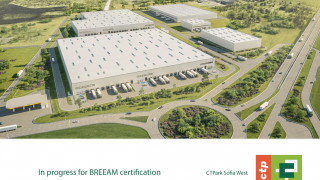What is BREAAM and why is it becoming more and more relevant today?
BREEAM is a globally recognized British methodology for assessing the building stock against sustainable indicators. If we have to assess sustainable construction practices, we can say that the standards and their implementation are still in an early stage of development. The persistent lack of precisely defined benchmarks for assessing sustainability in construction and design creates difficulties for the European Union in defining a common policy for reducing harmful emissions and combating climate change. It is the database generated during this type of certification that will be the foundation of future regulatory documents coming into force in the next few years. Let's not forget that last autumn 2021, COP26 was held, at which a general decision was made to reduce harmful emissions globally by 45% by 2030, with the European Union committing to a 55% reduction within the limits of the Community.
What is BREAAM's place in the overall project cycle and how does it change the environment and the responsibilities of the participants in the process?
When we talk about BREEAM, it's not just about sustainable construction, it's about a full process where all the decisions are carefully evaluated so that the result creates a minimal impact on the environment and the community, while also guaranteeing the quality of the final product - the building.
The BREEAM criteria help to assess the results achieved, which happens in several stages. The first is the preliminary one; then is the consideration of the idea and the investment intention, and based on the preliminary conversations with the participants in the process, an assessment is made - the so-called "preliminary report on achievement of indicators". It establishes the necessary indicators we need to implement in the project, based on function, location, planning solution, and physical characteristics. The achieved rating is defined once at the design level and a second time after construction – when the official documentation and supporting evidence are sent to BRE Global for audit and assessment. That way, through proper planning of the overall process, we stimulate sustainable practices in the design and construction of buildings and facilities.
What are the most common services customers search for with IPA?
At first, before we became auditors, we provided help and support in achieving sustainable parameters in the projects, thereby helping the smooth implementation of the certification process.
Currently, we are often asked for advice and quick reactions, and that is why our way of working is of great importance - our work in a BIM environment greatly helps the overall process, utilizing the preparation of a detailed digital prototype, enabling the faster realization of the necessary simulations to prove the physical parameters of the building. At IPA, we have always been pursued as specialists because of the quality of our services. We now provide the opportunity to conduct the entire certification process. As an auditor, I believe this is the most effective way to reach good results by working directly with the design team. The main advantage is the possibility of continuous direct monitoring of the design process and aid in making the necessary decisions regarding the certification process. When there are clear goals that you can discuss at any time, everything happens faster and without additional meetings, and in this closed loop, we save time through guaranteed quality.
Tell us about the process itself.
It starts with preliminary conversations with the investor, why this certificate would be useful for them, and how it would affect the overall process. Determination of the desired rating, project type, and degree of completion in the sense of the BREEAM criteria. Whether it is buildings that will be rented out or used for the given company, the BREEAM certification guarantees sustainable construction and a high level of living comfort, commensurate with global best practices.
During the entire process, the team responsible for sustainable development at IPA prepares several studies and reports, which help with the right design decisions and carry out a timely assessment of the various factors concerning a fruitful and trouble-free certification process.
Do you think that the investment in a sustainable and certified project is worth it from a business point of view and why?
By far the biggest benefit is that when we increase the capital costs in the project, we lower the operating costs. There are long and extensive studies saying that investing and putting funds into acquiring those indicators improves the functionality of the building and its presence in the environment. Such a building would be more energy efficient, more adaptable, and easier to manage, and these indicators are based on the best global practices, not on the unfortunately morally outdated normative base.
Everyone claims this method will save money in the long run, how does this actually happen?
This is where the main advantage of BREEAM comes in when we consider the overall life of an investment project. It is the balance between capital investments and operating costs - these are the main indicators that guide the process. We are increasingly being approached by customers who want to provide their employees with good working conditions - such as lighting, microclimate, temperature, and accessibility to services. The increased level of work comfort is one of the ways to provide the business with highly qualified personnel and their permanent integration into the life of the companies.
Lately, more and more often we have inquiries related to industrial buildings, whose potential owners are external companies, with a request for this type of certificate in their portfolio. This helps build the company's overall image and shows its commitment to environmental, climate, and social welfare issues.
The main advantage of such types of certificates is that they change the ratio between capital investments and operating costs in the long term. Within 5 to 10 years, all additional costs related to the certification are paid back, and the reduced expenses, easy building management, and guaranteed adaptability of the building to climate change remain. All this is achieved with proper structuring of capital investments leading to returns - related to the automation of the building and the achieved comfort with minimal energy use. In short, these additional costs at the beginning of an investment project improve its future, functionality, and energy security.
How did you manage to upgrade the design process to that of certification?
BIM in IPA helps to optimally achieve the set criteria through full integration with the additional software available to us. Building a realistic digital prototype enables timely simulations to ensure seamless high performance by enabling informed decision-making by our clients. Of course, we achieve all of this mainly with the help of the team that participates in this process - it is they who allow us to achieve the high quality of the service we offer.
What advice would you give to prospective investors, and what are the most important steps they should take?
A sustainable future is a matter of vision and good planning. At the very beginning of an investment project, sustainability criteria must be established - the earlier that happens, the more effective the entire process will be.
How do you envision the development of BREEAM in Bulgaria? Do you expect an impact from more developed countries and other factors to trigger it?
Trends in providing a sustainable amenity environment are yet to take hold in the real estate market. The saturation and supply of living and working areas will lead to an increase in the criteria of customers. Very often, not so much the price or the location that will determine the quality of a given building, then a direct declaration of achieved indicators - related to the comfort of living, energy efficiency, and accessibility. BREEAM certification unequivocally verifies the achieved performance so words like 'class' and 'category' hold real meaning, as they should.
What will the cities of the future be like?
We are currently witnessing the massive development of concepts for so-called Zero-Carbon-Cities in Europe - which is the drastic reduction of carbon emissions against the background of the overall urban environment. Limiting the harmful impact that new constructions have on the environment will define the future regulatory framework related to cities and the future. I believe that, against the background of changing climate conditions, in the future, we will all be obliged to achieve precisely defined parameters, which are now covered precisely employing the BREEAM criteria.
And what is the future?
Prevalent. The growth of the construction industry will be determined by how to achieve a sustainable construction business model that will adapt easier and cover regulations protecting the market and consumers. Increasingly, at the European level, bank financing is tied to the provision of sustainable indicators of investment. This can now be regulated strictly by achieving criteria laid down years ago in the BREEAM methodology.
Interview with Arch. Dimitar Dimitrov for "The City" magazine on 24.02.2022 with the original title "The sustainable future is a matter of vision and good investment planning"







